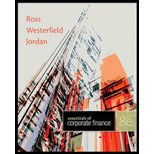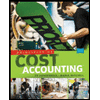
Essentials of Corporate Finance
8th Edition
ISBN: 9780078034756
Author: Stephen A. Ross, Randolph W. Westerfield, Bradford D. Jordan
Publisher: MCGRAW-HILL HIGHER EDUCATION
expand_more
expand_more
format_list_bulleted
Concept explainers
Question
Chapter 6, Problem 6.5BCQ
Summary Introduction
To discuss: The meaning of bid price and the meaning of ask price.
Introduction:
A bond refers to the debt securities issued by the governments or corporations for raising capital. The borrower does not return the face value until maturity. However, the investor receives the coupons every year until the date of maturity.
Expert Solution & Answer
Want to see the full answer?
Check out a sample textbook solution
Students have asked these similar questions
Question:
A company has issued a bond with a face value of $1,000, a coupon rate of 5%, and a maturity of 10 years. If the bond is currently trading at $950, what is the bondholder's yield to maturity (YTM), and how does it differ from the coupon rate? need help!!
A company has issued a bond with a face value of $1,000, a coupon rate of 5%, and a maturity of 10 years. If the bond is currently trading at $950, what is the bondholder's yield to maturity (YTM), and how does it differ from the coupon rate?
What is the time value of money, and why is it important in financial decision-making? Need help!
Chapter 6 Solutions
Essentials of Corporate Finance
Ch. 6 - What are the cash flows associated with a bond?Ch. 6 - What is the general expression for the value of a...Ch. 6 - Is it true that the only risk associated with...Ch. 6 - Prob. 6.2ACQCh. 6 - Prob. 6.2BCQCh. 6 - Prob. 6.2CCQCh. 6 - What is a junk bond?Ch. 6 - What does a bond rating say about the risk of...Ch. 6 - Prob. 6.4ACQCh. 6 - What do you think would be the effect of a put...
Ch. 6 - Prob. 6.5ACQCh. 6 - Prob. 6.5BCQCh. 6 - Prob. 6.5CCQCh. 6 - Prob. 6.6ACQCh. 6 - Prob. 6.6BCQCh. 6 - What is the term structure of interest rates? What...Ch. 6 - Prob. 6.7BCQCh. 6 - What are the six components that make up a bonds...Ch. 6 - Prob. 6.1CCh. 6 - Prob. 6.2CCh. 6 - Prob. 6.3CCh. 6 - Prob. 6.4CCh. 6 - Prob. 6.5CCh. 6 - Prob. 6.6CCh. 6 - Prob. 6.7CCh. 6 - Prob. 1CTCRCh. 6 - Prob. 2CTCRCh. 6 - Prob. 3CTCRCh. 6 - Prob. 4CTCRCh. 6 - Prob. 5CTCRCh. 6 - Prob. 6CTCRCh. 6 - Prob. 7CTCRCh. 6 - Prob. 8CTCRCh. 6 - LO3 6.9Bond Ratings. Often, junk bonds are not...Ch. 6 - Crossover Bonds. Looking back at the crossover...Ch. 6 - Municipal Bonds. Why is it that municipal bonds...Ch. 6 - Prob. 12CTCRCh. 6 - Prob. 13CTCRCh. 6 - Prob. 14CTCRCh. 6 - Prob. 15CTCRCh. 6 - Prob. 1QPCh. 6 - Interpreting Bond Yields. Suppose you buy a 7...Ch. 6 - Prob. 3QPCh. 6 - Prob. 4QPCh. 6 - Prob. 5QPCh. 6 - Prob. 6QPCh. 6 - Prob. 7QPCh. 6 - Prob. 8QPCh. 6 - Prob. 9QPCh. 6 - Prob. 10QPCh. 6 - Prob. 11QPCh. 6 - Prob. 12QPCh. 6 - Prob. 13QPCh. 6 - Prob. 14QPCh. 6 - Prob. 15QPCh. 6 - Prob. 16QPCh. 6 - Prob. 17QPCh. 6 - Prob. 18QPCh. 6 - Prob. 19QPCh. 6 - Prob. 20QPCh. 6 - Prob. 21QPCh. 6 - Prob. 22QPCh. 6 - Prob. 23QPCh. 6 - Prob. 24QPCh. 6 - Prob. 25QPCh. 6 - Prob. 26QPCh. 6 - Prob. 27QPCh. 6 - Prob. 28QPCh. 6 - Prob. 29QPCh. 6 - Prob. 30QPCh. 6 - Prob. 31QPCh. 6 - Prob. 32QPCh. 6 - Financing SS Airs Expansion Plans with a Bond...Ch. 6 - Financing SS Airs Expansion Plans with a Bond...Ch. 6 - Financing SS Airs Expansion Plans with a Bond...Ch. 6 - Financing SS Airs Expansion Plans with a Bond...Ch. 6 - Financing SS Airs Expansion Plans with a Bond...Ch. 6 - Financing SS Airs Expansion Plans with a Bond...Ch. 6 - Financing SS Airs Expansion Plans with a Bond...Ch. 6 - Financing SS Airs Expansion Plans with a Bond...Ch. 6 - Financing SS Airs Expansion Plans with a Bond...Ch. 6 - Financing SS Airs Expansion Plans with a Bond...
Knowledge Booster
Learn more about
Need a deep-dive on the concept behind this application? Look no further. Learn more about this topic, finance and related others by exploring similar questions and additional content below.Similar questions
- What is the time value of money, and why is it important in financial decision-making?arrow_forwardPlease don't use chatgpt. The formula for calculating the present value of a future amount is:A) Future Value × (1 + r)^nB) Future Value ÷ (1 + r)^nC) Future Value × (1 - r)^nD) Future Value ÷ (1 - r)^n help in this question.arrow_forwardThe formula for calculating the present value of a future amount is:A) Future Value × (1 + r)^nB) Future Value ÷ (1 + r)^nC) Future Value × (1 - r)^nD) Future Value ÷ (1 - r)^n need help!arrow_forward
- no ai What is the primary purpose of diversification in investing?A) To maximize returnsB) To eliminate all riskC) To reduce unsystematic riskD) To ensure stable dividendsarrow_forwardno chatgpt Which of the following is a capital structure decision?A) Deciding how much to pay in dividendsB) Deciding how to allocate funds to various projectsC) Deciding the mix of debt and equity financingD) Deciding how much inventory to purchase need help!arrow_forwardWhich of the following is a capital structure decision?A) Deciding how much to pay in dividendsB) Deciding how to allocate funds to various projectsC) Deciding the mix of debt and equity financingD) Deciding how much inventory to purchasearrow_forward
- No chatgpt!! The weighted average cost of capital (WACC) is used to:A) Measure the profitability of a companyB) Determine the cost of debt financing onlyC) Calculate the company’s average cost of financing from debt and equityD) Estimate the future stock price need help.arrow_forwardNo AI The weighted average cost of capital (WACC) is used to:A) Measure the profitability of a companyB) Determine the cost of debt financing onlyC) Calculate the company’s average cost of financing from debt and equityD) Estimate the future stock pricearrow_forwardCost of Trade Credit A large retailer obtains merchandise under the credit terms of 3/20, net 35, but routinely takes 65 days to pay its bills. (Because the retailer is an important customer, suppliers allow the firm to stretch its credit terms.) What is the retailer's effective cost of trade credit? Assume a 365-day year. Do not round intermediate calculations. Round your answer to two decimal places. The answer is not 27.09 which is incorrect.arrow_forward
- You invest $1,000 a year for 10 years at 6 percent and then invest $2,000 a year for an additional 10 years at 6 percent. How much will you have accumulated at the end of the 20 years? Answer: $49,967 *Please include all work & formulasarrow_forwardNo ai please! What is the role of an underwriter in an IPO?A) To lend money to the companyB) To set the dividend policyC) To buy the securities and sell them to the publicD) To manage the company’s operations need hearrow_forwardNo ai tool What is the role of an underwriter in an IPO?A) To lend money to the companyB) To set the dividend policyC) To buy the securities and sell them to the publicD) To manage the company’s operationsarrow_forward
arrow_back_ios
SEE MORE QUESTIONS
arrow_forward_ios
Recommended textbooks for you
 Cornerstones of Cost Management (Cornerstones Ser...AccountingISBN:9781305970663Author:Don R. Hansen, Maryanne M. MowenPublisher:Cengage LearningCentury 21 Accounting Multicolumn JournalAccountingISBN:9781337679503Author:GilbertsonPublisher:Cengage
Cornerstones of Cost Management (Cornerstones Ser...AccountingISBN:9781305970663Author:Don R. Hansen, Maryanne M. MowenPublisher:Cengage LearningCentury 21 Accounting Multicolumn JournalAccountingISBN:9781337679503Author:GilbertsonPublisher:Cengage Managerial AccountingAccountingISBN:9781337912020Author:Carl Warren, Ph.d. Cma William B. TaylerPublisher:South-Western College Pub
Managerial AccountingAccountingISBN:9781337912020Author:Carl Warren, Ph.d. Cma William B. TaylerPublisher:South-Western College Pub Principles of Cost AccountingAccountingISBN:9781305087408Author:Edward J. Vanderbeck, Maria R. MitchellPublisher:Cengage Learning
Principles of Cost AccountingAccountingISBN:9781305087408Author:Edward J. Vanderbeck, Maria R. MitchellPublisher:Cengage Learning

Cornerstones of Cost Management (Cornerstones Ser...
Accounting
ISBN:9781305970663
Author:Don R. Hansen, Maryanne M. Mowen
Publisher:Cengage Learning

Century 21 Accounting Multicolumn Journal
Accounting
ISBN:9781337679503
Author:Gilbertson
Publisher:Cengage


Managerial Accounting
Accounting
ISBN:9781337912020
Author:Carl Warren, Ph.d. Cma William B. Tayler
Publisher:South-Western College Pub

Principles of Cost Accounting
Accounting
ISBN:9781305087408
Author:Edward J. Vanderbeck, Maria R. Mitchell
Publisher:Cengage Learning
Pricing Decisions; Author: Rutgers Accounting Web;https://www.youtube.com/watch?v=rQHbIVEAOvM;License: Standard Youtube License